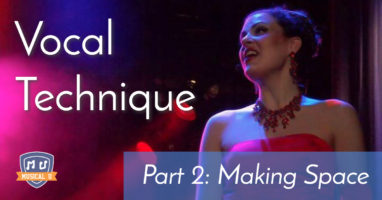Sometimes music seems simple. The beauty and grace of a song or piece can move you in such a deep and instinctive way, it’s hard to imagine the complexity that actually lies beneath. However, as we all know, when it comes to actually learning music you need to bravely face up to that complexity and tackle the details that make it all possible.
This week we explore the deceptive simplicity of pop music, dive deep into what makes tango tick, reveal the safe investments you can make among the seemingly endless range of options for spending your hard-earned music money, reveal a surprising body part that can make or break a professional singer, and transform a powerful tool from music theory into something simple enough to actually learn and use.
So no more shying away from the complexities – let’s dig in!
What makes music popular?
 It’s a genre we tend to take for granted, but there’s more to pop music than meets the ear… Or is there? Discover the history of pop music and its characteristic sounds in Open Your Ears to Pop.
It’s a genre we tend to take for granted, but there’s more to pop music than meets the ear… Or is there? Discover the history of pop music and its characteristic sounds in Open Your Ears to Pop.
Your parents were right – scientists have proven that modern pop music is actually ruining our brains. For more on the research, have a look at this article from Mic.com.
“I kissed a shark, and I liked it”? Love it or hate it, Pop music is here to stay. The Arc Magazine offers a philosophical defense pop music.
Do you think you know everything about pop music? Think again! This Must Be Pop lists 50 pop music facts that will blow your mind.
Put your money where your music is
 As musicians, we know that it’s worth investing in music. Our time, our effort… and our money! But how do you know what is worth investing money in and what isn’t? Musical U offers 3 sure-fire good investments for you to consider.
As musicians, we know that it’s worth investing in music. Our time, our effort… and our money! But how do you know what is worth investing money in and what isn’t? Musical U offers 3 sure-fire good investments for you to consider.
From three solid investments in your musical resources to seven uncommon career investments you can make: Bobby Borg for Sonicbids offers this interesting list.
One thing that’s important for performing musicians to invest in is a good website. Around here we’re big fans of Bandzoogle. In this interview with Music Think Tank, Bandzoogle’s CEO explains why your website should not be a blog.
It also pays to invest in good recording devices. But which one? The Bulletproof Musician has you covered, with reviews of the top five recording devices.
Tickled by Tango
 A moving but mysterious genre: what makes tango tick? We spoke with Charlotte Dupuis of successful tango band Nueva Nocturna to find out what she loves about tango and how we too can learn to more deeply appreciate tango music.
A moving but mysterious genre: what makes tango tick? We spoke with Charlotte Dupuis of successful tango band Nueva Nocturna to find out what she loves about tango and how we too can learn to more deeply appreciate tango music.
If you’re looking to open your ears to tango music, have a look at this beginners guide from Todo Tango. In addition to this listening guide, they are a great resource for all things tango.
Or if you’d like to learn more about the history of tango and its most important artists, check out this impressive “periodic table of tango” from music educator Julian Hasse.
Have you ever thought about writing a tango yourself but don’t know where to begin? Composer Focus offers this “how-to” for writing your own tango music.
Making Space to Sing
 Recently Musical U published an article on the three skills that form the basis for correct singing. So if the fundamentals of singing are that simple, how come it takes professional opera singers upwards of 10 years to fully train their voice? Marisa Balistreri reveals one body part that holds the answer.
Recently Musical U published an article on the three skills that form the basis for correct singing. So if the fundamentals of singing are that simple, how come it takes professional opera singers upwards of 10 years to fully train their voice? Marisa Balistreri reveals one body part that holds the answer.
Vocalist Marisa Balistreri was lucky to have learned a technique passed down from the great tenor Franco Corelli. Here, you can learn from the Maestro, too, in this recording of one of his master classes.
It’s important to lower the larynx when you sing, but only if done correctly. Voice teacher Franco Tenelli gives advice on how to avoid the dangerous pitfalls of this sometimes misunderstood technique.
Another important aspect of singing mentioned in this week’s article is that of vowel formation for singers. In this article, Karyn from Singwise gives an extensive explanation of how to form and modify vowels.
Simplifying the Circle of Fifths
 If you’ve played music for a few years you will certainly have heard of the “Circle of Fifths” but do you know what it is, or how it is used? If not, you’re missing out on a powerful tool that can unlock deep musical understanding for you. Learn the basics of the circle, including why it’s useful and how to learn it fast, in “What is the Circle of Fifths?“.
If you’ve played music for a few years you will certainly have heard of the “Circle of Fifths” but do you know what it is, or how it is used? If not, you’re missing out on a powerful tool that can unlock deep musical understanding for you. Learn the basics of the circle, including why it’s useful and how to learn it fast, in “What is the Circle of Fifths?“.
Professional “Musician / Adult Without a Plan” Sean Daniel applies the Circle to three different uses in this easy-to-understand video:
The circle of fifths generates every chord and every scale using the 12 tones of the western music system. Tyler Gutherman of Sound Bridge dives deeper into the world of scales, intervals, the circle of fifths, and diatonic chords.
There’s no shortage of different versions of a Circle of Fifths diagrams around the internet, but this one from Rand Scullard is also interactive. Neat!
To succeed in music you need to be willing to take on the hard work required to transform complexity and detail into the simple and beautiful experience we want our listeners to enjoy. Fortunately, as the articles above reveal, sometimes the complexity beneath the simplicity can itself be made simple. When it comes to learning music hard work doesn’t always have to be so hard!







